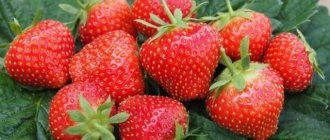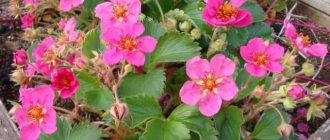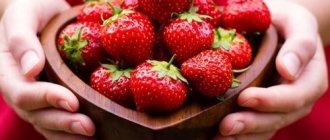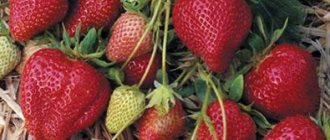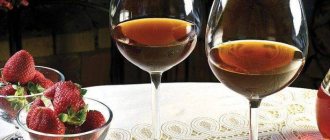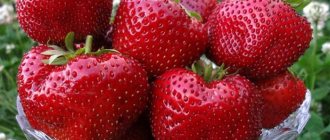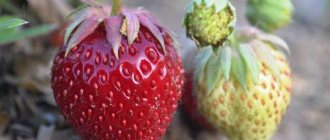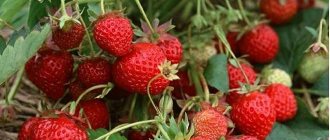Many summer residents especially like to grow berries; the Kama strawberry is very popular. With proper care of the variety, you can observe indicators such as high yield and presentation, which is confirmed by numerous photos of the harvest. And reviews from gardeners prove that the variety really deserves the attention of both beginners and professionals.
Main characteristics and description of the strawberry variety Kama
The bushes are not very tall; they are compact, but with powerful roots. The foliage is medium in size, slightly wrinkled, with pubescence on the reverse side, dark emerald in color. Peduncles are formed in medium numbers, drooping, strong, and grow below the level of foliage. Up to 5-7 ovaries are formed on each peduncle.
The flowers are produced in both male and female types, medium in size with white petals and a bright yellow center. Whiskers are formed in small quantities, but they are quite large.
Strawberry variety "KAMA" - video
Ripe fruits can be either cone-shaped or rounded-diamond-shaped with a clearly visible neck. The berries are lightly ribbed and have a characteristic shine. The skin can be from red to dark red or burgundy in color. The pulp is slightly compacted, very sweet. The seeds are yellow in color, pressed shallowly into the skin.
On a note!
The weight of ripe Kama strawberry fruits is up to 30 g, the first harvest can be much larger.
The highest yield and large berry size of this garden strawberry are observed in the first season after planting the seedlings. Over the next couple of seasons, the size of the berries begins to decrease, and the yield decreases. Therefore, it is recommended to replace the plantation of this strawberry once every 3-4 seasons.
The strawberry variety Kama received the highest rating from tasters - 5 points for the size, taste of the fruit and high yield.
The berries are versatile - they can be used fresh, added to desserts, decorated with confectionery, made into jam and marmalade, and frozen for the winter. When frozen, the berries do not lose their shape, taste and aroma.
Description
This variety was bred by Polish breeders and became widespread due to its unpretentiousness, rapid ripening and excellent taste characteristics. So, let’s get acquainted with the description of the strawberry variety “Kama”.
Bushes
Strawberry bushes "Kama" are of medium height and grow very compactly, which is how this variety differs from others. The leaves are small in size, have a dark green tint, and are heavily pubescent at the bottom. Under the leaves there are flower stalks, which after a certain time become berries. Thanks to this arrangement, the fruits are always protected and closed from birds.
Berries
Strawberry fruits are bright red in color, the average weight of one berry is about 20 g. They have a classic shape, slightly ribbed. The fruit seeds are located shallowly. The taste is sweet and rich, the aroma is pleasant, with strawberry notes. The berries collected in the first harvest are always larger than the rest.
Read the description and features of growing strawberry varieties: “Albion”, “Gigantella”, “Queen Elizabeth”, “Elizabeth 2”, “Mashenka”, “Russian size”, “Lord”, “Marshal”, “Asia”, “Malvina” ", "Alba", "Kimberly", "Zenga Zengana", "Fresco", "Chamora Turusi", "Queen", "Maxim", "Eliane", "Clery", "Honey", "Mara de Bois", "Crown".
Productivity of the Kama variety
Since the Kama variety is remontant,
then the bushes can be harvested several times a season. The first wave of ripe fruits ripens early - they are harvested from the last ten days of May to the first ten days of June. The next harvests can be harvested approximately 2.5-3 weeks after the previous waves.
At least 1-1.2 kg of ripe produce is collected from each Kama bush
, which is a fairly high yield for remontant strawberries.
Care
The Kama variety does not require much care. They take care of him according to the standard scheme.
Watering
Kama is a moisture-loving plant, so watering should occur regularly.
Despite its drought resistance, strawberries need timely watering , which is carried out once a week in hot weather. If the weather is cloudy and rainfall occurs regularly, then additional watering is not required. They mainly use a drip irrigation system.
Feeding
You can determine the need for fertilizing yourself : if you observe abundant growth of the bush, it means that the plant does not have enough potassium. This problem can be solved by adding additional saltpeter or wood ash.
Diseases and pests
Kama strawberries are quite resistant to most diseases characteristic of this berry crop. But it is noted that the resistance of the variety to white and brown spotting is slightly below average. Therefore, it is recommended to carry out preventive treatment of strawberry plantations with a fungicide solution. The fungicide “Horus” is recognized as the most effective of them against these diseases.
The drug is used several times per season:
- Before the buds appear, the product is diluted in the following concentration: 6 g per bucket of water;
- when the ovaries appear, the solution is prepared as follows: 3 g of the drug is dissolved in a bucket of water;
- 7-12 days before harvesting ripe fruits, the concentration of the treatment solution should be as follows: 3 g of the drug is diluted in a bucket of water.
For 1 acre, no more than 5 liters of working solution of Horus fungicide is required.
The main pest that attacks Kama strawberry bushes is the strawberry mite. The most effective insecticidal drug in the fight against it is Actellik. The working solution for treating strawberry plantations is prepared as follows: 10 ml of the product is diluted in a bucket of water. For 10 m2, 1.5 liters of this solution is enough. To completely “deal” with these “harmful” bugs, a couple of treatments with an interval of 13-15 days are enough.
Important!
The last treatment of Kama strawberries against pests should be carried out 20-22 days before the expected collection of ripe berries.
Collection and storage of garden strawberries
Before harvesting, stop watering the bushes abundantly. This is necessary so that the berries are not watery and can remain collected for more than 1-2 days. The fruits are removed with the stalk, with which they will be stored much longer than without it. Harvest in the morning, after the dew has subsided, or in the evening, when the sun's rays are no longer so scorching.
The peculiarity of Kama strawberries is that they have dense berries that do not crush during transportation. Therefore, it can be successfully transported and also stored for a long time. To do this, the berries are placed in boxes covered with paper. The fruits must be free of damage and dents. There is no need to wash them before storing them.
Note! Garden strawberries do not have the ability to ripen after picking the berries. Kama strawberries have a unique strawberry aroma and taste, which is why both gardeners and gourmets love them
In addition, housewives dry it, freeze it, and make compotes, jams, and preserves from it. In addition, strawberries contain a large amount of useful substances that they can supply the body with throughout the year.
Kama strawberries have a unique strawberry aroma and taste, which is why both gardeners and gourmets love them. In addition, housewives dry it, freeze it, and make compotes, jams, and preserves from it. In addition, strawberries contain a large amount of useful substances that they can supply the body with throughout the year.
Pros and cons
The main advantages of the Kama strawberry variety include:
- The first harvest from this strawberry plantation can be harvested in the last ten days of May;
- remontability of the Kama variety - up to 3 harvests can be harvested per season;
- provided that a layer of mulch is added under the strawberry bushes, this variety can easily withstand periods of drought;
- mustaches are formed in limited quantities, so you do not have to remove them regularly;
- the fruits are large in size and have a beautiful presentation;
- excellent taste of Kama strawberries and the persistent aroma of ripe berries;
- good yield;
- the ability to grow the variety in greenhouse conditions, while obtaining very early harvests.
Excellent varieties of strawberries:
Strawberry Marshall Strawberry Albion Strawberry Malga
The main disadvantages of the variety include:
- the bushes are quite spreading, each producing a large number of leaves;
- each bush requires a lot of space to receive the required amount of nutrients;
- peduncles do not grow higher than the foliage;
- the Kama variety is characterized by low resistance to brown and white spotting;
- blooming buds do not tolerate cold temperatures below 0 degrees Celsius, therefore, during the period of budding and flowering, in case of threat
- In case of returning spring frosts, it is necessary to cover the beds with Kama strawberries with agrofibre.
Planting remontant strawberries Kama
Kama strawberries are one of the unpretentious and non-capricious varieties of this berry crop, so there is no special trouble with them when planting and further growing them. Almost all seedlings, if the planting rules are followed, take root, quickly acclimatize and grow. The variety is also undemanding in terms of care - it is enough to follow basic agrotechnical rules to obtain good harvests every year.
You should purchase strong, healthy seedlings of the Kama variety for planting - order them from a nursery or from trusted suppliers. Healthy seedlings have a strong and strong root system at least 15 cm long, without visible damage or traces of disease.
The foliage of such seedlings is a rich emerald color, also without traces of disease. Immediately before planting, the roots of the seedlings are inspected, shortened by several centimeters, and parts that are damaged or have signs of disease are also removed.
Planting remontant strawberries in the fall - video
Important!
The area for remontant Kama strawberries should be well illuminated by sunlight; in the shade, Kama strawberries will grow worse, and its berries will be small and sour.
You should also follow the rules of crop rotation. It is strictly forbidden to plant this berry crop after large plants that greatly deplete the soil - after sunflowers or Jerusalem artichokes.
The best predecessors for strawberries will be plants from the family of cruciferous plants, legumes and green crops, onions or garlic. You can plant it after tomatoes or cucumbers, but it is not advisable.
Stages of planting Kama strawberries:
- The soil must be fertile and loose enough to freely allow oxygen and moisture to pass through to the root system.
- Before planting strawberry seedlings, humus and wood ash are added to the soil, then the soil is dug up and loosened.
- Immediately before planting, the roots of the seedlings need to be dipped in a weak solution of potassium permanganate to disinfect, then placed in the holes.
- The roots are carefully straightened along the diameter of the hole, the top is filled with soil and compacted.
- Then make abundant watering.
- After watering, the soil is loosened again and covered with a layer of mulch.
It is better to plant the Kama strawberry variety in rows. In this case, the distance between neighboring plants should be about 0.4-0.5 m, and the row spacing should be 0.6-0.8 m. The bushes should not be planted more densely, otherwise it will be difficult for the grown plants to receive adequate nutrition from the soil.
Landing technique
Kama variety strawberries are best planted at the end of July. In this case, the first full harvest can be obtained as early as next year. If planting is done in the fall, the seedlings may not have time to take root and will die. If you plant seedlings at the end of August, then the bushes will have little time to develop and lay flower buds, which determine the yield of the next season.
For planting, two types of planting material are used: with an open root system and with a closed one (ZKS). Seedlings with ZKS have better survival rate, but higher cost. Based on the description of the Kama variety, it is better to use one- or two-line planting with a distance between plants of about 30 cm, while the row spacing should be at least 40-60 cm. Planting can be done either in individual holes or in a common furrow. The first method is used for small areas, the second - when planting plantations.
When planting, each plant is buried to the level of its growing point. It is prohibited to bury growth buds into the ground. Such plants will soon die. Exposing the roots is also harmful. Roots located on the soil surface will die during wintering. After planting, the soil around each plant must be compacted so that there are no air cavities left. After this, abundant watering is carried out.
Further care for Kama strawberries
Young plants should be watered daily until complete acclimatization, or at least every other day.
When the plants take root, reduce the amount of watering. But you need to know - provided the soil is mulched after watering, Kama strawberries can withstand long periods of drought. If mulching is not carried out, then in hot weather the strawberry plantation will have to be watered frequently, and after each addition of moisture the soil should be loosened to break up the crust that appears on the surface.
REPAIR STRAWBERRY!! CARE FEATURES - video
The harvest of ripening Kama strawberries is collected regularly to allow new fruits to ripen. After the berries turn red, they need to be given a couple more days to fully ripen.
Advice!
Wooden planks or slate are placed under drooping flower stalks with ripening fruits to prevent rotting of the fruits.
If slugs or grape snails appear on the site, a layer of pine needles is poured around the strawberry bushes, which will repel these pests from the ripening berries.
Feeding the berry garden
This strawberry variety is remontant; to obtain several harvests per season, the plants require regular fertilizing. Humus and ash are used as fertilizers, which are a source of many minerals, in particular potassium. But you can also use complex mineral fertilizer as a top dressing.
For the first time, you should apply fertilizer to Kama garden strawberries before budding begins.
. During the same period, preventive treatment of the strawberry plantation against pests (weevils or strawberry mites) is carried out, and the bushes should also be sprayed with a fungicide solution against various spots.
Preparing for winter
When preparing a strawberry plantation for the winter, the beds are covered with spruce branches, straw or fallen leaves. With the onset of frost, the strawberry bushes are covered with non-woven material.
With the onset of spring, the shelter must be removed.
How to prepare strawberries for winter - video
Propagation of garden strawberries
The culture can reproduce in three ways. The method can be selected depending on personal preferences. The use of whiskers is a common propagation method, but seeds can also be used.
Dividing the socket
To use this method, it is necessary to separate the rosette along with the root from the mother bush. The resulting shoot is planted in the ground; this method is often used, but can be harmful to the mother bush.
Mustache division
The bushes are left, from which the inflorescences are removed. The released mustache is dug into the ground, and after the cutting takes root, it is cut off and transplanted into a separate hole. This type of plant replanting is harmless to the mother bush and allows you to get up to 7 cuttings at once.
Seeds
To obtain seeds, you must perform the following algorithm:
- choose berries that are ripe and have no visible damage;
- the berries are kneaded to a pulp;
- the resulting slurry is dried for several days, after which it is washed with clean water;
- the resulting seeds are dried and used to grow seedlings.
To obtain seedlings, you need to plant the seeds in a container with a fertile mixture and cover with a plastic bag until shoots emerge. After the shoots appear, it is necessary to open the container daily for 30 minutes to harden the sprouts. The time gradually increases. Seedlings are planted in the soil after 4-6 leaves appear.
Strawberry Kama: reviews from those who planted the variety
Ira, 40 years old, Perm region: I have been growing this variety of strawberries in my garden for several seasons. I would like to note that Kama fruits begin to ripen at the end of May, and fruiting continues throughout the season, since Kama strawberries are a remontant variety. The largest berries ripen in the spring; subsequent fruits are not so large, but with excellent taste and aroma. I recommend Kama strawberries to all gardeners.
Olga, 60 years old, Stavropol region: In our region, Kama strawberries can be grown without shelter for the winter, since we practically never have frosts. True, in hot weather it needs to be watered often and the soil mulched, otherwise the berries will dry out. I like the fact that the Kama variety is remontant, so the berries can be picked throughout the summer.
Natalya, 30 years old, Labinsk: I have been growing strawberries for a long time, and I grow them for further sale. Recently, I have been growing the Kama strawberry variety - early ripening, remontant and high-yielding. I planted a couple of beds in a greenhouse, so I harvest my first strawberry harvest in mid-April - the harvested fruits are sold out very quickly, as the berries are tasty, sweet and aromatic.
Kama strawberries are one of the best remontant varieties that can be grown not only in garden beds, but also in greenhouses, thereby obtaining super early harvests.
Since this variety has a fairly high yield, and the berries tolerate transportation well at different distances, many gardeners grow the variety for further sale. Kama strawberries are also often grown on an industrial scale.
Reviews from gardeners
Victor Yuryevich, Lvov, 52 years old.
Kama is a good early ripening strawberry variety. The berries are very tasty, aromatic, weighing up to 50 g. The variety produces almost no mustache, which I consider a huge advantage. In our conditions, he suffered from spotting several times, although treatments were carried out. Because of this, I had to replace the variety with Olvia, which I later replaced with Honey.
Natalya Yurievna, Kyiv, 53 years old.
The variety is good. I would even say beautiful. Now I grow it as my main one (together with 4 other varieties). The bushes are well developed and abundantly covered with foliage. The inflorescences are located below the level of the leaves. My berries grew up to 60 g, although such huge sizes are rare. The berries have a sweet and sour taste and smell very strongly of strawberries. The pulp is dense. I really like the variety, I don’t plan to change it yet.
Dmitry Ivanovich, Moscow, 43 years old.
Interesting variety. I would not recommend it for mass production, since technically ripe berries are quite sour. When fully ripe, they become burgundy and very sweet. And the aroma is simply fabulous. But then transportability is very poor and they are not stored for very long.

